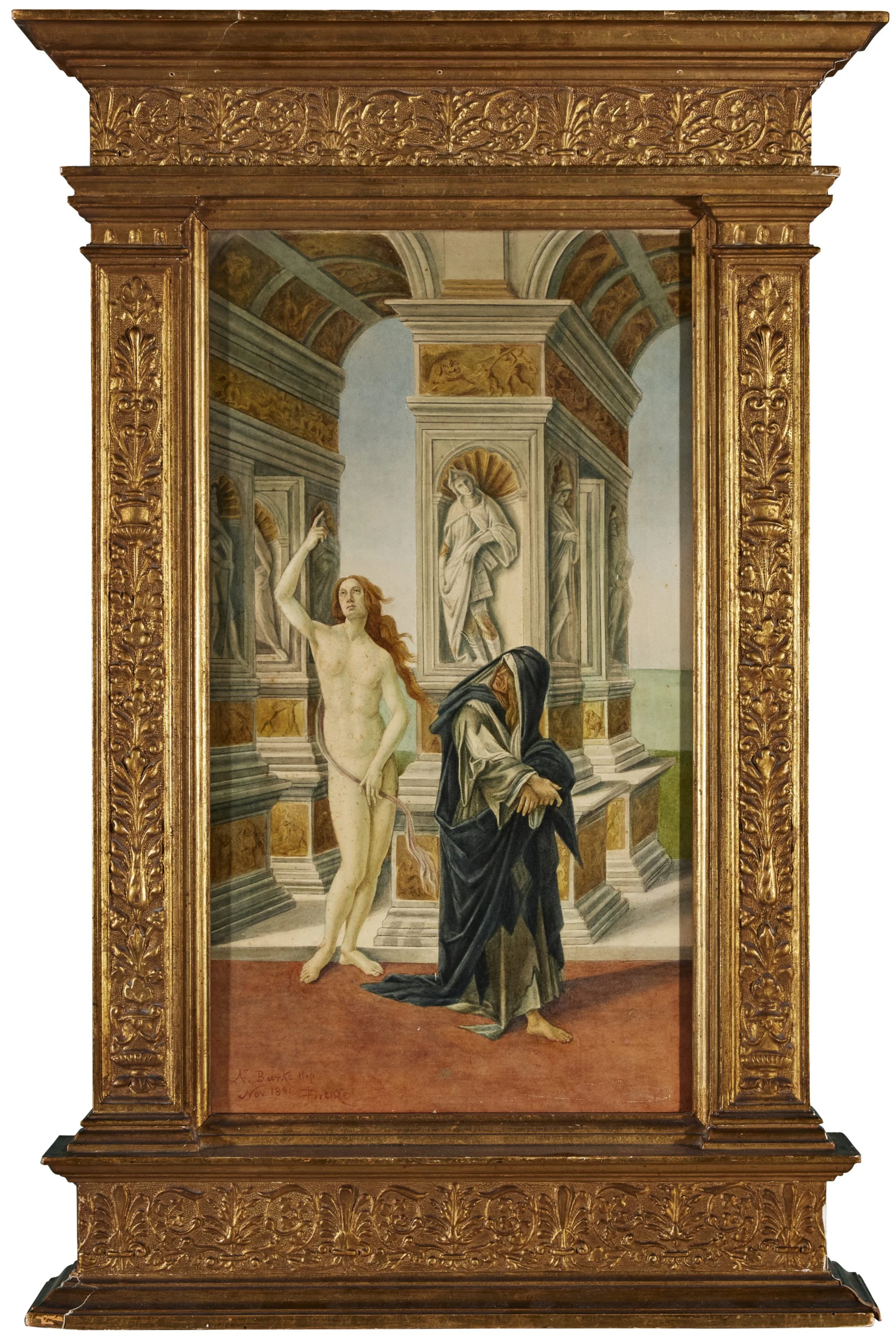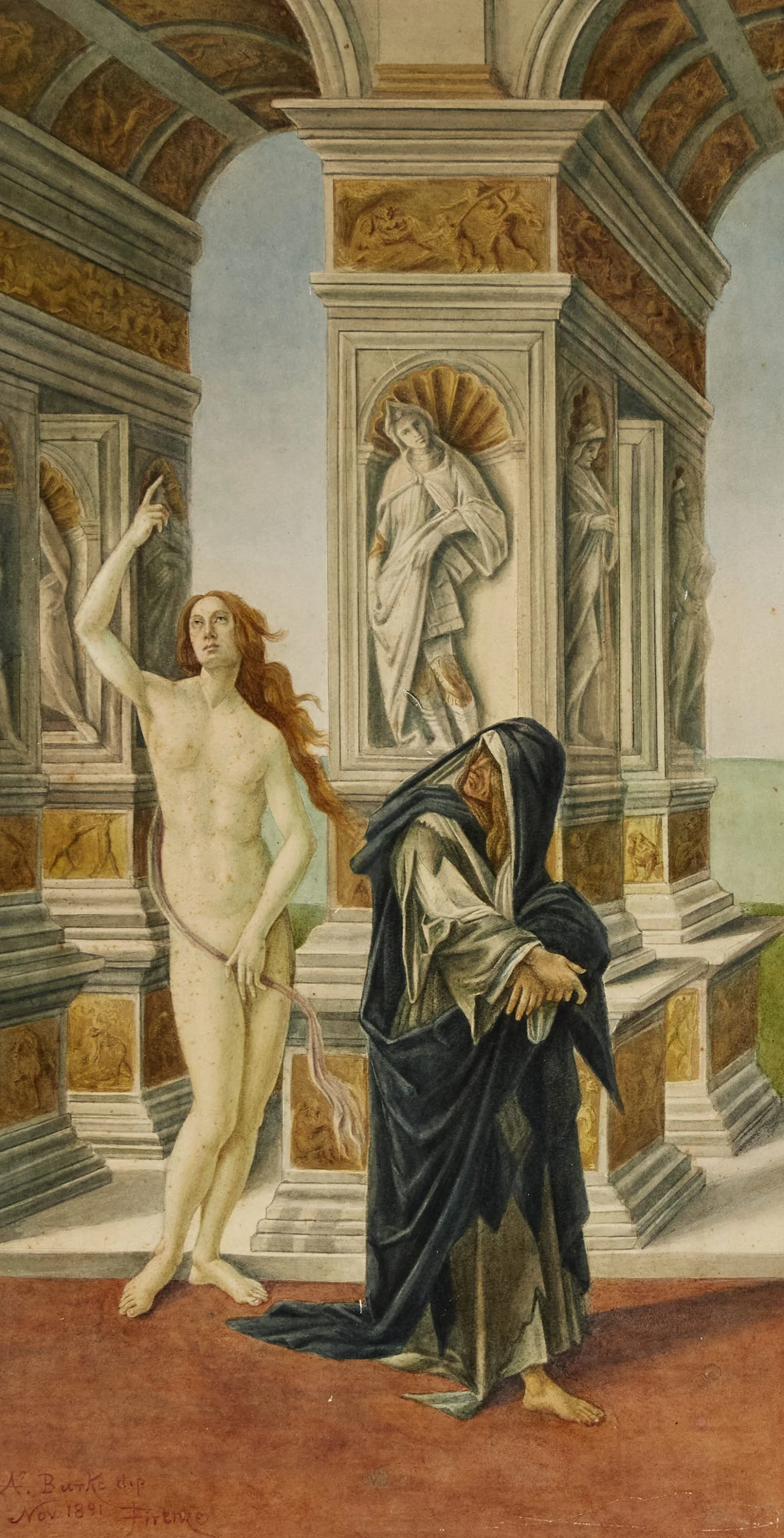 Image 1 of 2
Image 1 of 2

 Image 2 of 2
Image 2 of 2



2. Augustus Nicholas Burke R.H.A. 1838-1891
Price: Enquire
‘The Calumny of Apelles (After Sandro Botticelli)’
Watercolour on card, laid down on linen, 62 x 35cm
In original Renaissance style tabernacle frame
Signed and dated Nov 1891, Firenze
Inscribed Verso: Signoria Burke (the artist’s sister), 22 Via da Marmora, Ullimo
Augustus Nicholas Burke (1838–1891) was born in County Galway. He studied Fine Art in London and began exhibiting at the Royal Academy in 1863. He returned to Ireland in 1869 and settled in Dublin, where he gained a reputation as a skilled landscape and subject painter. His brother, Thomas Henry Burke, the Under-Secretary for Ireland, was assas- sinated in May 1882 by a group of Irish nationalists known as the Invincibles. This event led to Burke’s abrupt departure from Ireland in 1883. He settled in London, but declining health forced him to move to Florence in 1889. He died on 28 December 1891 at his residence at 22 Via da Marmora, Florence. This would likely make the painting depicted above his final work. ‘The Calumny of Apelles’ by Sandro Botticelli, painted in 1495, is housed in the Uffizi Gallery, Florence. Interestingly, this too was Botti- celli’s last major work. Burke’s copy includes only a portion of Botticelli’s composition. He focused on the two figures on the far right: the elderly wom- an dressed in black, representing Penitence, who turns her gaze towards the ethereal nude figure of Truth. Truth, full of indignation, gestures upward toward the heavens, awaiting the divine judgment from God. Both painters, in what may be seen as their final artistic statements, emphasised the endur- ing importance of justice and truth.
Price: Enquire
‘The Calumny of Apelles (After Sandro Botticelli)’
Watercolour on card, laid down on linen, 62 x 35cm
In original Renaissance style tabernacle frame
Signed and dated Nov 1891, Firenze
Inscribed Verso: Signoria Burke (the artist’s sister), 22 Via da Marmora, Ullimo
Augustus Nicholas Burke (1838–1891) was born in County Galway. He studied Fine Art in London and began exhibiting at the Royal Academy in 1863. He returned to Ireland in 1869 and settled in Dublin, where he gained a reputation as a skilled landscape and subject painter. His brother, Thomas Henry Burke, the Under-Secretary for Ireland, was assas- sinated in May 1882 by a group of Irish nationalists known as the Invincibles. This event led to Burke’s abrupt departure from Ireland in 1883. He settled in London, but declining health forced him to move to Florence in 1889. He died on 28 December 1891 at his residence at 22 Via da Marmora, Florence. This would likely make the painting depicted above his final work. ‘The Calumny of Apelles’ by Sandro Botticelli, painted in 1495, is housed in the Uffizi Gallery, Florence. Interestingly, this too was Botti- celli’s last major work. Burke’s copy includes only a portion of Botticelli’s composition. He focused on the two figures on the far right: the elderly wom- an dressed in black, representing Penitence, who turns her gaze towards the ethereal nude figure of Truth. Truth, full of indignation, gestures upward toward the heavens, awaiting the divine judgment from God. Both painters, in what may be seen as their final artistic statements, emphasised the endur- ing importance of justice and truth.